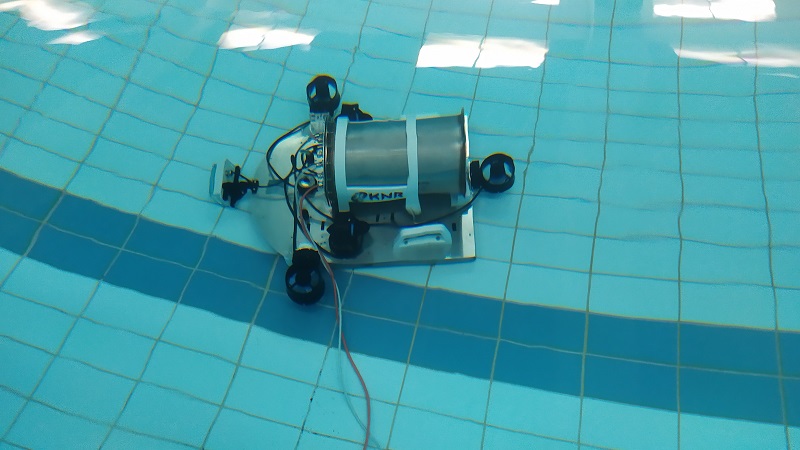OKOŃ – a WUT student-designed autonomous underwater vehicle

A visualization of the OKOŃ V2 underwater vehicle – the project received an award in the 2021 Student Construction Competition
The new project by the Robotics Research Group (KNR) team has two main prizes in the national Student Construction Competition under its belt. Let’s take a closer look at OKOŃ!
The Robotics Research Group (KNR) at the Faculty of Power and Aeronautical Engineering is a collective well known for projects designed to compete in international tournaments, as well as for the impressive experience of its members. There is no shortage of people keen to join the KNR. But how do you combine the implementation of large projects and the involvement of more students in the work? By creating new teams and new projects dealing with further branches of robotics.
Stage 1. Difficult beginnings
“Two of our colleagues – Krzysztof Choszczyk and Piotr Saffarini – found interesting competitions in a fairly niche category – the ROV and AUV competitions, i.e. robotic submarine tournaments (ROV – remotely operated, AUV – autonomous),” says Hubert Graczyk, a student of applied automation and robotics at the Faculty of Electrical Engineering and project coordinator. “Krzysztof and Piotr suggested that people with technical experience should create a core team that would be involved in the construction of the vehicle, and the council of our Group suggested the majority of people involved in this project should be newcomers. This is how our team was formed. It was later named OKOŃ.”
"We wanted the name to be associated with Poland and the fish that live in our waters [okoń is Polish for perch],” says Graczyk.
It was early 2019.
“We built the robot’s pre-prototype from the cheapest elements and offcuts of old projects,” Graczyk recalls. “Nevertheless, the robot began to take shape over time. For us, it was a great experience and we developed our creative skills.”
The students set themselves a goal – to participate in the largest underwater robot competitions, in Singapore and the United States. They worked hard, even at night.
Stage 2. Pool problem
“We managed to build a working, watertight prototype of the robot,” says Graczyk. "We were able to control the engines and preview the front camera. But the robot looked really ghastly. It was really just a tin platform to which we attached a welded barrel with simple electronics inside.
Another challenge the team faced was limited access to the test environment, namely the swimming pool. This meant that you had to be ideally prepared each time you tested the robot.
Stage 3. First feats
But the hard work began to pay off. In addition to the fun they had in improving the robot, the team were also successful in receiving funding from a Polish ministerial program “Najlepsi Najlepszych 4.0!”. Thanks to this, the dream of going to international competitions and participating in scientific conferences felt more and more within reach.
“We completed the minimum plan needed to qualify for the Singapore AUV Challenge 2020, we recorded a promotional film and a video showing the work of the robot according to the organisers’ requirements", recalls Graczyk. “It was a great start to the year for our team – we found out we had been qualified for the competition in mid-January 2020. We also registered for a remotely operated robot competition called the International SeaPerch Challenge, as well as the MATE Turkey Regional ROV Competition.
Then the pandemic broke out, the organisers first postponed the competitions and then cancelled them altogether. None of the scheduled conferences took place either.
Stage 4. Motivated by KOKOS
The team’s spirits were lifted when OKOŃ won the main prize in the Smart Robots category of the Konkurs Konstrukcji Studenckich (KOKOS) 2020, a student construction competition.
It was a spur for further action.
Developers started work on a software with a graphic interface that allowed intuitive control of the robot and on a simulator that allowed for preliminary testing without the need for a swimming pool.
Mechanics designed a proper mechanical construction.
Electronic engineers have improved the robot so that it is possible to develop it on a modular basis in the future without having to replace old circuits. This is intended to reduce costs and the working time needed to develop the robot further, and to save space inside the robot.
Stage 5. OKOŃ becomes a Joker!
With such a developed project, the team took part in this year’s edition of the KOKOS Competition, this time in the Joker category.
“Collectively we decided that this would be more appropriate and fair to the organisers, given that the new version of the robot has not been physically assembled, the new hull has not yet been manufactured to our order, which means the robot has not yet been integrated as a whole,” says Graczyk.
The team took part in the competition and was successful again.
Stage 6. A move to a wider playing field
Now it’s time for further work.
“We are hoping for a quick end to the pandemic so we can return to testing the robot in its natural habitat,” Graczyk says. “We would also like to compete around the world, although we are aware that this may not happen very quickly. Competition organisers have suspended their information pages or said in advance that their next competitions would take place no sooner than 2022.”
The team’s priority is to improve the simulator, and to make a new mechanical design and electronic system, which will be easy and inexpensive to expand in the future.
“We place great emphasis on the modular nature of the robot and the flexibility to adapt its capabilities, so that it easily finds its way through various competitions,” Graczyk says. “This approach leaves us an open door for cooperation with other project teams and external entities, and makes the project easy to scale – increasing the team will not paralyse the project, but will expand its activities with the design of new functional modules.”
There is no shortage of ideas for building new modules.
“We are already working on a set of different types of interchangeable grippers and a module with a transducer for detecting sound that spreads through water,” Graczyk says. “We would also like to create a small manipulator, a universal measuring module for testing the composition of water, a device for the ejection of sunken objects, and even a system for recovering portions of energy while in operation that uses photovoltaic panels or the magnetohydrodynamic effect.”
Members of the OKOŃ Team:
- Hubert Graczyk, Faculty of Electrical Engineering – project coordinator, electronic engineer,
- Maciej Morawski, Faculty of Power and Aeronautical Engineering / Faculty of Electronics and Information Technology – coordinator of the mechanical section,
- Ernest Szypuła, Faculty of Electrical Engineering – coordinator of the programming section,
- Kamil Jankowski, Faculty of Power and Aeronautical Engineering – budget and administrative affairs,
- Patryk Niemiec, Faculty of Mechatronics – programmer (object detection, autonomy development, simulator),
- Kajetan Jonak, Faculty of Power and Aeronautical Engineering – programmer (adjustment system, graphic user interface application),
- Mikołaj Kordowski, Faculty of Electrical Engineering – programmer (creator of simulation environment),
- Norbert Prokopiuk, Faculty of Power and Aeronautical Engineering – programmer (gripper operation, simulation),
- Maksymilian Cebula, Faculty of Mechatronics – mechatronics (torpedoes, structural elements, low-level programming),
- Jakub Konador, Faculty of Mechatronics – constructor (mechanical construction, drum gripper),
- Jakub Gawron, Faculty of Mechatronics – constructor (mechanical construction, technical documentation),
- Arkadiusz Strzała, Faculty of Electrical Engineering – electronics (measuring transducers).








